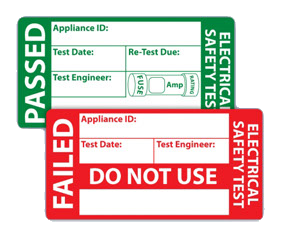Electrical Testing
PAT Testing
What is PAT Testing?
Portable Appliance Testing includes a series of inspections and electrical tests on each item. These tests vary depending on the class of the item.
A visual inspection is carried out to check for faults / damage to the:
- Plug Casing - (Damaged or scorch marked)
- Damage to the flex of the appliance.
- The wiring of the plug is checked to ensure connections and secure termination
- The fuse rating of the plug is checked

Once these visual tests have been carried out a number of electrical tests are performed depending on the class of the equipment:
- Insulation test
- Earth bond test
- Earth continuity test
- Touch leakage test
- Leakage test
- Polarity test
Appliance testing results are then stored onto our testing equipment and the electrical item marked accordingly with a pass or fail label.
What to do if your appliance fails a test?
In most circumstances an appliance that has failed a test is easily repaired on site. Most faults occur during the visual inspection, and can usually be rectified by replacing the plug or flex.
If the item is not repairable, we will remove the plug from the appliance immediately. This ensures that the item is not accidentally plugged into the mains electricity supply, we will notify you of any items that are beyond repair.
The testing Engineer will then return to our office and download the entire test results from your site.
These are then compiled into a report and returned to you in CD format with a free viewer program for your PC or paper format for you to store in your files. We hold copies of all the test results at our office.
Pricing
We believe in a clear pricing structure so that you can accurately determine the price you will pay. All charges are made on a per appliance basis depending on the total number of items to be tested.
There are no hidden charges - Our prices include “Out of Hours” & weekend service, labeling, test reports, certificates etc. Please contact us for an individual quote to your requirements.
Pricing includes:
- Full visual inspection of the items to be tested
- Out of hours and weekend service
- Required electrical tests
- Pass or Fail labels
- Certificates
- All travelling time
We offer a fixed rate of £45.00 for less then 20 appliance tests within a 25 mile radius of our Ripley office.
Prices start from as little as £0.75 per item tested.
Periodic Test & Inspection
At M Kemp Electrical Testing Services we ensure that your electrical installations conform to the latest safety guidelines from the British Standards and the Institution of Engineering and Technology (IET) as codified in BS 7671, Requirements for Electrical Installations.
This is especially important as the Building Regulations Part P Electrical Safety now applies to all fixed electrical installations (for operation at low voltage or extra-low voltage) that are not controlled by the Electricity Supply Regulations 1988 or the Electricity at Work Regulations 1989.
We will arrange a site visit to test and inspect all the fixed wiring system. The test will comply with BS7671 for current legislation. Upon completion we will issue a Periodic Inspection report, and list any recommendations and observations. Any remedial works will be then quoted and discussed for a further visit.
BS 7671 : states and we comply with: regulations to the design, erection and verification of electrical installations, also additions and alterations to existing installations. Existing installations that have been installed in accordance with earlier editions of the Regulations may not comply with this edition in every respect. This does not necessarily mean that they are unsafe for continued use or require upgrading.
Guidelines for testing
- Domestic - Change of occupancy or 10 years
- Hospitals - 5 years
- Industrial - 3 years
- Offices - 5 years
- Shops - 5 years
- Churches - 5 years
- Theatres - 3 years
- Public houses - 5 years
- Construction sites - 3 months
Click here to visit the British standards website.
